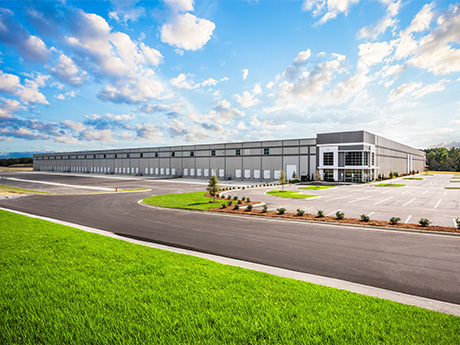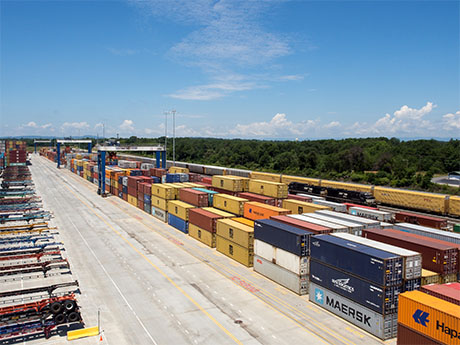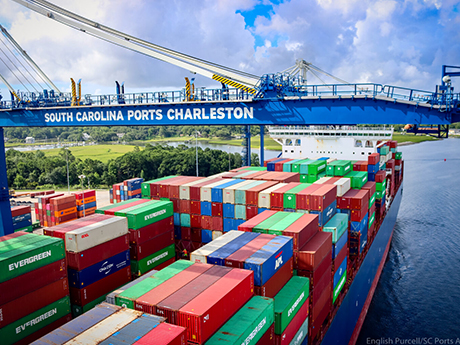More than seven months have passed since Liberation Day, where the Trump administration declared a sweeping package of tariffs for foreign trade partners and specific commodities, including steel and aluminum. Since the announcement in early April, there has been a boon in the amount of multibillion-dollar advanced manufacturing, life sciences, semiconductor and data center investment announcements around the country, with the markets along the I-85 Industrial Corridor being no exception. To name a few: Toyota has recently begun production at its $13.9 billion battery plant in Liberty, N.C.; Rivian broke ground on its $5 billion electric vehicle plant near Social Circle, Ga.; JetZero is planning to create 14,500 jobs for an aerospace manufacturing facility in Greensboro, N.C.; Eli Lilly is developing a $5 billion pharmaceutical manufacturing facility in the Richmond suburb of Goochland County, Va.; and Google is developing a trio of data centers in metro Richmond’s Chesterfield County. “We have incredible momentum bringing business back into the United States, which is going to drive industrial growth, particularly in the Southeast,” says Jim Anthony, CEO and founder of APG Companies. “We’re not unionized, we have lower taxes, fewer regulations and lower cost of energy, which is huge factor in site …
Market Reports
AlabamaGeorgiaIndustrialMarket ReportsNorth CarolinaSouth CarolinaSoutheastSoutheast Market ReportsVirginia
FloridaGeorgiaMarket ReportsNorth CarolinaSouth CarolinaSoutheastSoutheast Market ReportsStudent Housing
Universities, Student Housing Properties in Southeast Contend with Hurricane Helene
by John Nelson
Hurricane Helene made landfall in Northwestern Florida on Thursday, Sept. 26, after being upgraded to a major Category 3 storm that afternoon. Widespread damage across a number of Southeastern states followed in its wake, with many areas experiencing flooding, downed trees, power outages and road closures. At least 175 people have died across six states, according to reports by CNN and The New York Times, and officials fear that the death toll is likely to rise with many remaining missing. Hundreds of roads remain closed across the Southeast — especially in Western North Carolina and East Tennessee, which were hit particularly hard by the hurricane — hampering the delivery of supplies, and more than 2 million customers remain without power. Student Housing Business reached out to universities, owners, operators and students across the Southeast to check in on how they fared during the storm and their experience in the aftermath. Owners, Operators Weigh In Denver-based Cardinal Group tracked its communities in Alabama, Arkansas, Florida, Georgia, Kentucky, North Carolina, South Carolina, Tennessee, Virginia and West Virginia through Hurricane Helene. “Of those communities, four experienced power outages and several had minor roof leaks and flooding, with the largest impact felt in Asheville and Boone, North Carolina,” says Jenn Cassidy, president of property operations …
Over the course of this year, Greenville-Spartanburg’s industrial market is expected to continue its overall upward trajectory with increasing rental rates, record-low vacancy rates and ongoing tenant demand. The fundamentals of Upstate South Carolina’s industrial market are among the strongest anywhere in the country right now due to a myriad of cylinders on which it is simultaneously firing. The market’s plethora of demand drivers include e-commerce users, manufacturing, the automotive industry and the draw of the Inland Port located in Greer. To understand the full picture, however, it’s important to also consider what the Greenville- Spartanburg market is not firing on. The market is not stifled by unions, high regulation or the lack of viable sites, available buildings and utility infrastructure some other markets have to contend with. An important factor affecting current absorption is multiple fourth-quarter tenant occupancy dates being pushed from fourth quarter of 2022 to first quarter of 2023. There was 17.9 million square feet of industrial space under construction at year-end 2022, with approximately 4 million square feet of that already preleased but not yet delivered. Those deliveries in early 2023 will naturally lead to positive absorption and help rebalance the market. A variety of industrial …
As port authorities around the country invest billions of dollars in infrastructural improvements, industrial users are taking notice and looking for sites near all the action. In the Southeast, the elevated demand for new industrial space near the Port of Savannah and Port of Charleston is pushing the boundaries as far as what’s considered normal levels for property performance indicators such as new construction, rent growth and leasing activity. “It’s hard to say that anything is ‘normal’ right now — there are a lot of new phenomena out there,” says Robert Barrineau, senior vice president of CBRE’s Charleston office. “We are seeing nationally now that a tie to a seaport as being key for economic growth and for operational efficiencies for companies.” In one of the bigger announcements in 2022, Hyundai Motor Group chose a 3,000-acre site in Bryan County, which is close to both the Port of Savannah and Interstate 95, for its $5.5 billion manufacturing plant. Construction is already underway, and the facility should be operating at full capacity, which entails production of 300,000 units annually, by the first half of 2025. The South Korean automotive giant intends to use a combination of local labor and AI technology …
In 2019, the Greenville-Spartanburg industrial market added an unprecedented 33 buildings encompassing 10 million square feet of inventory, bringing the total market size to approximately 211 million square feet. Despite record-breaking new deliveries, absorption has kept pace at 9.6 million square feet the same year. This market is preparing for future growth with delivery of available buildings and land sites, as well as investment in infrastructure and the overall workforce. With the increased supply of Class A speculative space, the market has seen numerous company expansions and relocations away from its Class B product type. New, modern space provides the efficiencies and amenities companies desire (i.e. above 32-foot clear heights). In order to service customers’ consumption preferences, companies are making capital investments into automated processes that allow them to stay competitive in a rapidly changing supply chain. One of the earliest signs of momentum in 2020 was the announcement of South Greenville Enterprise Park and its first user investment, Vermeer. South Greenville Enterprise Park is the first industrial park to deliver to the Greenville market in 10 years. Primary investment has been focused on the S.C. Highway 101 and S.C. Highway 290 corridors due to demand drivers such as BMW …
There is a lot of buzz about the dominance of e-commerce and its effects on the industrial market. Columbia has its fair share of retailers with e-commerce distribution facilities as Amazon, The Home Depot and Target all have major distribution centers in the Midlands region of South Carolina. However, retail distribution is not the main driver of this industrial market. The heart and soul of the central South Carolina industrial market is manufacturing. Manufacturing properties make up approximately 35 percent of the 70 million square feet of industrial product in the Columbia metropolitan statistical area. While the balance of space is classified as warehouse/distribution, a large portion of that is used to service manufacturers, pushing the total amount of manufacturing-related space well above 50 percent. Since 2013, the pace of South Carolina’s manufacturing job growth has been four times faster than the national growth rate. This manufacturing renaissance has created demand for Class B multipurpose buildings that have manufacturing infrastructure, such as heavy electric services, cranes, HVAC and support facilities including locker rooms, restrooms, cafeteria and parking to handle larger employee requirements. In the 1970s and 1980s, industrial buildings constructed in central South Carolina were part manufacturing facility and part …
Thirty years ago, there were 33 operating textile mills in Spartanburg County, South Carolina. Today, there are scarcely a handful. The jobs and investments disappeared in the wake of regulatory change and international trade agreements. However, the infrastructure, location, existing workforce and entrepreneurial attitude of the area’s leadership saw this as a challenge to evolve. And evolve it did — using the substrate of the textile industry as a solid foundation. The well-trained and manufacturing-oriented workforce, coupled with the existing manufacturing support base (specialty machinery fabrication including maintenance and constituent chemical suppliers), were readily adaptable to new and recast job opportunities. This was the canvas on which the area’s evolution would be painted. Specialty equipment, manufacturing, fabrication, chemical production and other vestiges of the textile industry have remained demand drivers for the Upstate market. They have been reconfigured in the form of investment and expansion by Milliken & Co., Toray Carbon Fiber, General Electric and Keurig Green Mountain. The existing manufacturing-oriented workforce, with its previous experience and mindset, were a prime reason BMW selected Spartanburg County as the home for its first North America production facility. BMW’s Plant Spartanburg and its vast supplier and related support network have emerged as …
The Greenville-Spartanburg economy has a long legacy of being fueled by industrial activity. Today, the whole Upstate market continues to experience record levels of growth as it evolves into advanced manufacturing, automotive and distribution related activities. South Carolina is the largest exporter of goods on a per capita basis in the Southeast and has one of the highest densities of foreign direct investment per capita in the United States. The Upstate is the manufacturing center of South Carolina, with approximately 55 percent of the market’s 177 million square feet of industrial space classified as manufacturing. Due to the strong fundamentals of the market, manufacturing is expected to continue to grow. The metro offers manufacturers a pro-business environment, with skilled and affordable labor, a critical mass of industry and a solid transportation infrastructure with access to high population bases. Strategic Location The region is also becoming increasingly crucial to supply chains serving the East Coast and Southeast. The Upstate can reach over 95 million people within a day’s truck drive. With the continued proliferation of e-commerce, the Greenville-Spartanburg market provides an opportunity to mitigate transportation costs by allowing companies to leverage Inland Port Greer, which provides overnight service to and from …
The city of Greenville and the surrounding submarkets are exploding with growth. The once-sleepy textile town in the Upstate of South Carolina has now become a robust, diversified economy that is garnering interest from retailers that may have overlooked the market in the past. The change in the city of Greenville has not gone unnoticed; several publications and top ten lists have recognized Greenville for its thriving downtown. From the addition of Falls Park in 2004, an approximately 32-acre oasis in the West End of the city, to multiple mixed-use developments under construction, Greenville’s resurgence has brought new residents, new retail and new life to the region. Growth in the Greenville market has been largely driven by the addition of thousands of new jobs, a low cost of living and highly attractive lifestyle options. Greenville serves as the North American headquarters for BMW, Michelin and Hubbell Lighting, all of which have contributed to significant job growth in the region. As Greenville’s downtown has continued to draw national recognition, retailers have taken notice. In recent years, Greenville has attracted a multitude of national retailers new to the market. Hughes Development’s Project ONE kicked things off when it brought national retailers like …
It is impossible to have a discussion about retail commercial real estate without considering the implications of shifting demographics. This is true both nationally and in the Columbia market. The unique demographic characteristics of the local market serve as an explanation for the current situation in retail real estate. The trends in retail real estate in Columbia echo those on that national level, although with the local market’s heavy concentration of Millennials (one of the highest in the Southeast), the opportunity for disproportionately high growth is significant. Those trends involve the sector being the last to emerge from the recession with low levels of retail development on a broad scale, but increasing activity and viability in urban and infill environments, especially for restaurants. Much of the retail activity in the market uniquely caters to that 20 to 34 age demographic. At this stage in their lives, the overwhelming majority of the younger demographic is focused on living in an active lifestyle, preferably in urban environments. This is making the prospect of infill retail, particularly as a component of mixed-use development, more feasible. This is resulting in increasing retail and multifamily development in Columbia’s downtown. For urban retail, there are three …
Newer Posts









